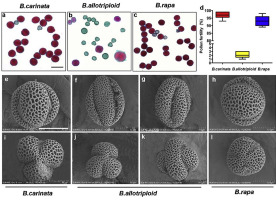当前位置:
X-MOL 学术
›
Plant Physiol. Biochem.
›
论文详情
Our official English website, www.x-mol.net, welcomes your
feedback! (Note: you will need to create a separate account there.)
Cytological atlas at meiosis reveals insights into pollen fertility in synthetic Brassica allotriploids between allotetraploid B. carinata and diploid B. rapa.
Plant Physiology and Biochemistry ( IF 6.1 ) Pub Date : 2020-01-07 , DOI: 10.1016/j.plaphy.2020.01.003 Yan Yang 1 , Ge Yan 2 , Zishuang Li 3 , Jiachen Yuan 3 , Xiaochun Wei 4 , Fang Wei 1 , Baoming Tian 2 , Zhengqing Xie 2 , Gongyao Shi 1 , Xiaowei Zhang 4 , Gangqiang Cao 2
Plant Physiology and Biochemistry ( IF 6.1 ) Pub Date : 2020-01-07 , DOI: 10.1016/j.plaphy.2020.01.003 Yan Yang 1 , Ge Yan 2 , Zishuang Li 3 , Jiachen Yuan 3 , Xiaochun Wei 4 , Fang Wei 1 , Baoming Tian 2 , Zhengqing Xie 2 , Gongyao Shi 1 , Xiaowei Zhang 4 , Gangqiang Cao 2
Affiliation

|
The formation of allopolyploid crops basically depends on the successful interspecific hybridization and polyploidization, which generally involves in a combination of distinct but related genomes from independent species. But cytological analysis of these initially synthesized allohaploids immediately after genome merging is poorly explored in regards to anther and pollen development to date. In this study, Brassica trigenomic allohaploids (ABC) were produced to investigate the immediate effects of the genome combinations on pollen fertility during anther development via crosses between natural allotetraploid B. carinata (BBCC) and diploid B. rapa (AA). The results showed that in the synthetic Brassica allotriploids (ABC), the anther development was completely disrupted, and the pollen grains were mostly inviable with varied genetic complements. In addition, the meiosis course was aberrantly altered and eccentric chromosomal configurations including multivalent, bridges and lags occurred frequently during metaphase I to anaphase II. Genomic in situ hybridization (GISH) further revealed that B genome of homoeology was frequently apt to interact with A and C genomes, and cytoskeletal organizations was improperly distributed during meiosis in these synthetic Brassica allotriploids. Furthermore, we also confirmed that the expression of typical meiosis-related genes was obviously repressed during anther development in these Brassica allotriploids. Taken together, our results provide a detailed cytology for insights into pollen development in the synthetic allotriploid hybrids, which are conventionally considered as a useful genetic resource for polyploid Brassica breeding.
中文翻译:

减数分裂的细胞学地图集揭示了对异源四倍体B. carinata和二倍体B. rapa之间的合成芸苔属异三倍体花粉育性的见识。
异源多倍体作物的形成基本上取决于成功的种间杂交和多倍体化,这通常涉及来自独立物种的独特但相关的基因组的组合。但是到目前为止,关于花药和花粉发育的研究很少探讨这些最初合成的异源单倍体的细胞学分析。在这项研究中,产生了芸苔属三基因组异源单倍体(ABC),以研究基因组组合对花药发育过程中花粉育性的直接影响,这是通过天然异源四倍体B. carinata(BBCC)和二倍体B. rapa(AA)之间的杂交来实现的。结果表明,在合成的芸苔属同化三倍体中,花药发育被完全破坏,并且花粉粒大多具有不同的遗传补体。此外,减数分裂过程被异常改变,在中期I到后期II期间频繁发生偏心染色体构型,包括多价,桥和滞后。基因组原位杂交(GISH)进一步揭示,同源的B基因组经常易于与A和C基因组相互作用,并且在减数分裂过程中这些合成的芸苔属异三倍体中细胞骨架组织分布不当。此外,我们还证实,在这些芸苔属异三倍体花药发育过程中,典型的减数分裂相关基因的表达明显受到抑制。两者合计,我们的结果提供了详细的细胞学信息,以了解合成异源三倍体杂种中的花粉发育,而异源三倍体杂种通常被视为多倍体芸苔属育种的有用遗传资源。减数分裂过程被异常改变,在中期I到后期II时常发生偏心染色体构型,包括多价,桥和滞后。基因组原位杂交(GISH)进一步揭示,同源的B基因组经常易于与A和C基因组相互作用,并且在减数分裂过程中这些合成的芸苔属异三倍体中细胞骨架组织分布不当。此外,我们还证实,在这些芸苔属异三倍体花药发育过程中,典型的减数分裂相关基因的表达明显受到抑制。两者合计,我们的结果提供了详细的细胞学信息,以了解合成异源三倍体杂种中的花粉发育,而异源三倍体杂种通常被视为多倍体芸苔属育种的有用遗传资源。减数分裂过程被异常改变,在中期I到后期II时常发生偏心染色体构型,包括多价,桥和滞后。基因组原位杂交(GISH)进一步揭示,同源的B基因组经常易于与A和C基因组相互作用,并且在减数分裂过程中这些合成的芸苔属异三倍体中细胞骨架组织分布不当。此外,我们还证实,在这些芸苔属异三倍体花药发育过程中,典型的减数分裂相关基因的表达明显受到抑制。综上所述,我们的研究结果提供了详细的细胞学信息,以了解合成异源三倍体杂种中的花粉发育,而异源三倍体杂种通常被认为是多倍体芸苔属育种的有用遗传资源。
更新日期:2020-01-07
中文翻译:

减数分裂的细胞学地图集揭示了对异源四倍体B. carinata和二倍体B. rapa之间的合成芸苔属异三倍体花粉育性的见识。
异源多倍体作物的形成基本上取决于成功的种间杂交和多倍体化,这通常涉及来自独立物种的独特但相关的基因组的组合。但是到目前为止,关于花药和花粉发育的研究很少探讨这些最初合成的异源单倍体的细胞学分析。在这项研究中,产生了芸苔属三基因组异源单倍体(ABC),以研究基因组组合对花药发育过程中花粉育性的直接影响,这是通过天然异源四倍体B. carinata(BBCC)和二倍体B. rapa(AA)之间的杂交来实现的。结果表明,在合成的芸苔属同化三倍体中,花药发育被完全破坏,并且花粉粒大多具有不同的遗传补体。此外,减数分裂过程被异常改变,在中期I到后期II期间频繁发生偏心染色体构型,包括多价,桥和滞后。基因组原位杂交(GISH)进一步揭示,同源的B基因组经常易于与A和C基因组相互作用,并且在减数分裂过程中这些合成的芸苔属异三倍体中细胞骨架组织分布不当。此外,我们还证实,在这些芸苔属异三倍体花药发育过程中,典型的减数分裂相关基因的表达明显受到抑制。两者合计,我们的结果提供了详细的细胞学信息,以了解合成异源三倍体杂种中的花粉发育,而异源三倍体杂种通常被视为多倍体芸苔属育种的有用遗传资源。减数分裂过程被异常改变,在中期I到后期II时常发生偏心染色体构型,包括多价,桥和滞后。基因组原位杂交(GISH)进一步揭示,同源的B基因组经常易于与A和C基因组相互作用,并且在减数分裂过程中这些合成的芸苔属异三倍体中细胞骨架组织分布不当。此外,我们还证实,在这些芸苔属异三倍体花药发育过程中,典型的减数分裂相关基因的表达明显受到抑制。两者合计,我们的结果提供了详细的细胞学信息,以了解合成异源三倍体杂种中的花粉发育,而异源三倍体杂种通常被视为多倍体芸苔属育种的有用遗传资源。减数分裂过程被异常改变,在中期I到后期II时常发生偏心染色体构型,包括多价,桥和滞后。基因组原位杂交(GISH)进一步揭示,同源的B基因组经常易于与A和C基因组相互作用,并且在减数分裂过程中这些合成的芸苔属异三倍体中细胞骨架组织分布不当。此外,我们还证实,在这些芸苔属异三倍体花药发育过程中,典型的减数分裂相关基因的表达明显受到抑制。综上所述,我们的研究结果提供了详细的细胞学信息,以了解合成异源三倍体杂种中的花粉发育,而异源三倍体杂种通常被认为是多倍体芸苔属育种的有用遗传资源。











































 京公网安备 11010802027423号
京公网安备 11010802027423号